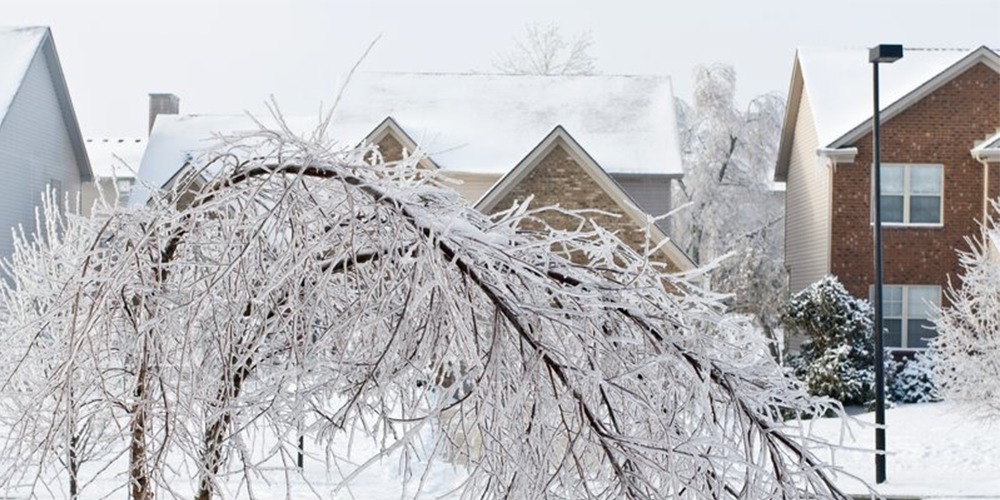
Various Damages Caused by the Freezing Rain
Freezing rain can cause various types of damage due to the ice it creates. Some of the common types of damage caused by freezing rain include:
1. Transportation Disruption: Freezing rain can create slippery conditions on roads, sidewalks, and runways, making travel hazardous. It can lead to accidents, traffic jams, and disruptions in public transportation systems.
2. Power Outages: The weight of ice accumulated on power lines and tree branches can cause them to break and fall, leading to power outages. This can result in loss of heating during cold weather, disruption of communication systems, and inconvenience for residents and businesses.
3. Damage to Infrastructure: Ice accumulation on buildings, bridges, and other structures can cause structural damage over time. It can also lead to water leakage into buildings as the ice melts.
4. Tree and Plant Damage: Freezing rain can coat trees and plants with a layer of ice, causing branches to break under the weight. This can damage vegetation and landscaping, impacting ecosystems and agricultural activities.
5. Injury Risk: The slippery conditions created by freezing rain increase the risk of slips, falls, and other injuries for pedestrians and workers who need to be outdoors.
6. Disruption of Services: Freezing rain can disrupt various services such as emergency response, healthcare, and education due to transportation difficulties and power outages.
7. Economic Impact: The damage caused by freezing rain can result in significant economic losses due to repair and recovery costs, decreased productivity, and disruption of business operations.
Frequently Occurring Places for Freezing Rain
Freezing rain is more common in certain regions due to specific atmospheric conditions. These regions typically experience a combination of cold surface temperatures and warmer air aloft, creating a layer of freezing air near the ground where rain can freeze upon contact.
1. North America: Freezing rain is quite common in parts of Canada and the northern United States during the winter months. Areas such as the Great Lakes region, the Northeastern United States, the Midwest, and parts of the Canadian Prairies often experience freezing rain events.
2. Europe: Countries in Northern Europe, including the United Kingdom, Scandinavia, and parts of Central Europe, can experience freezing rain, especially in colder winters.
3. Russia: Regions of Russia, particularly Siberia and areas near the Arctic Circle, experience freezing rain as part of their winter weather patterns.
4. East Asia: Parts of East Asia, including northeastern China, Korea, and Japan, can experience freezing rain during the winter months.
5. Mountainous Regions: Mountainous areas around the world, such as the Alps in Europe, the Rocky Mountains in North America, and the Himalayas in Asia, can experience freezing rain due to temperature variations with altitude.
6. Southern Hemisphere: While less common, some regions in the Southern Hemisphere, such as parts of South America (e.g., southern Argentina and Chile), southern Australia, and New Zealand, can experience freezing rain under certain weather conditions.
How to Ease the Damage Caused by Freezing Rain on Infrastructure?
Several strategies and measures can be taken to help mitigate and ease the damage caused by freezing rain to infrastructure:
1. Preventive Maintenance: Regular inspection and maintenance of infrastructure, such as bridges, buildings, power lines, and roads, can help identify and address vulnerabilities before freezing rain events occur. This includes checking for weak points, ensuring proper insulation, and repairing any existing damage.
2. Weather Monitoring: Utilize weather monitoring and forecasting systems to stay informed about approaching freezing rain events. Early warning systems can provide valuable time to prepare and take preventive measures.
3. De-icing and Anti-icing Techniques: Implement de-icing and anti-icing techniques to prevent the buildup of ice on surfaces. This can include applying salt or chemical de-icers on roads, walkways, and bridges before freezing rain occurs to reduce ice formation and improve traction.
4. Vegetation Management: Trim trees and vegetation near infrastructure to reduce the risk of branches breaking and falling onto power lines, buildings, or roads during freezing rain events.
5. Structural Design: Design infrastructure with materials and features that can withstand freezing rain and ice accumulation. For example, using weather-resistant materials, reinforcing structures, and incorporating drainage systems to prevent water accumulation and ice formation.
6. Emergency Preparedness: Develop and maintain emergency response plans for dealing with freezing rain-related damage. This includes having equipment and personnel ready to address power outages, road closures, and other infrastructure disruptions.
7. Public Awareness and Education: Educate the public about the risks and safety measures during freezing rain events. Encourage residents and businesses to take precautions, such as avoiding unnecessary travel, using alternative transportation methods, and reporting hazards promptly.
8. Collaboration and Coordination: Foster collaboration between government agencies, emergency services, utility providers, and community organizations to coordinate efforts and resources for effective response and recovery during freezing rain events.
By implementing a combination of these strategies and working collaboratively, it is possible to reduce the damage caused by freezing rain to infrastructure and improve overall resilience to winter weather hazards.
Post time: Apr-10-2024
 +86-13376814803
+86-13376814803  robert@hzhongtai.com
robert@hzhongtai.com 











